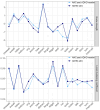Stimulant medication and symptom interrelations in children, adolescents and adults with attention-deficit/hyperactivity disorder
- PMID: 39527154
- PMCID: PMC12198274
- DOI: 10.1007/s00787-024-02610-8
Stimulant medication and symptom interrelations in children, adolescents and adults with attention-deficit/hyperactivity disorder
Abstract
Stimulant medication is effective in alleviating overall symptom severity of attention-deficit/hyperactivity disorder (ADHD), yet interindividual variability in treatment response and tolerability still exists. While network analysis has identified differences in ADHD symptom relations, the impact of stimulant medication remains unexplored. Increased understanding of this association could provide valuable insights for optimizing treatment approaches for individuals with ADHD. In this study, we compared and characterized ADHD symptom networks (including 18 ADHD symptoms) between stimulant-treated (n = 348) and untreated (n = 70) individuals with ADHD and non-ADHD controls (NACs; n = 444). Moreover, we compared symptom networks between subgroups defined by their stimulant treatment trajectory (early-and-intense use, late-and-moderate use). Stimulant-treated individuals with ADHD showed stronger associations between symptoms, compared with untreated individuals with ADHD and NACs. We found no differences in symptom networks between the stimulant treatment trajectory subgroups. Prospective longitudinal studies are needed to disentangle whether the identified differences stem from treatment or pre-existing factors.
Keywords: Attention-deficit/hyperactivity disorder; Psychopharmacology; Stimulant medication; Symptom networks.
© 2024. The Author(s).
Conflict of interest statement
Declarations. Ethical approval: This study was performed in line with the principles of the Declaration of Helsinki. Approval was granted by the medical ethical committees of the VU University Medical Centre and Radboud University Medical Centre (NL23894.091.08). Informed consent: We obtained written informed consent from all participants aged 12 years and older, and from parents for participants under 18, for participation in the NeuroIMAGE study and use of their de-identified data in analysis and publications. Competing interests: JB has been in the past 3 years a consultant to / member of advisory board of / and/or speaker for Takeda, Medice, Angelini, Boehringer-Ingelheim, and Servier. He is not an employee of any of these companies, and not a stock shareholder of any of these companies. He has no other financial or material support, including expert testimony, patents, and royalties. All other authors have no competing interest or industry support to report.
Figures


References
-
- Sonuga-Barke E, Kostyrka-Allchorne K (2022) Editorial Perspective: Attention-deficit/hyperactivity disorder viewed as neuro-divergence in the digital world. Journal of Child Psychology and Psychiatry. Advance online publication - PubMed
-
- Sonuga-Barke E, Thapar A (2021) The neurodiversity concept: is it helpful for clinicians and scientists? Lancet Psychiatry 8(7):559–561 - PubMed
-
- American Psychiatric Association (2013) Diagnostic and statistical manual of mental disorders, 5th edn. American Psychiatric Publishing
-
- Willoughby MT (2003) Developmental course of ADHD symptomatology during the transition from childhood to adolescence: a review with recommendations. J Child Psychol Psychiatry Allied Discip 44(1):88–106 - PubMed
MeSH terms
Substances
Grants and funding
LinkOut - more resources
Full Text Sources
Medical

